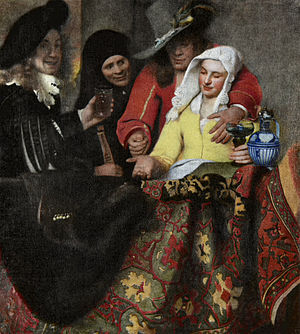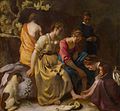With the matchmaker

|
| With the matchmaker |
|---|
| Jan Vermeer , 1656 |
| Oil on canvas |
| 143 × 130 cm |
| Old Masters Picture Gallery |

The matchmaker has an oil painting by Jan Vermeer from 1656. The 143 centimeter high and 130 centimeter wide picture shows a four-figure genre scene set in a brothel . It is the first known painting by Vermeer's today that can be assigned to this type of painting. It is part of the collection of the Old Masters Picture Gallery in Dresden .
Image description
The picture near the matchmaker shows four almost life-size figures that are located behind a barrier that covers the body from the chest down. They communicate both with each other and with the viewer. The old woman dressed in black, the young girl and the suitor hugging her from behind form a thematic and compositional unit. The man on the left edge of the picture, wearing a beret and looking out of the picture, is instead off the scene. He toasts the viewer with a glass in his hand and takes a mediating position between him and what is happening in the picture. He wears clothes similar to the man in Die Malkunst and is considered to be a kind of self-portrait by Vermeer's. The client is paying, which is evident from the coin in his hand and the prostitute's open hand, and he grabs the prostitute's chest with his other hand. Both are observed by the coupler from the background. The young woman and the suitor, with the yellow, red and white clothes, form the color highlight of the picture, which attracts the viewer's gaze. The woman grasps a wine glass that is standing next to a carafe on the barrier and is slightly blushed. The white lace cap stands in contrast to what she is doing. Her face is emphasized both by the position in the bright light and by the optical retraction of the suitor's head. His facial features are only partially visible under the large hat that casts a shadow. Jan Vermeer made a few changes to him during the painting process, most of all undoing the eye contact that had prevailed between him and the girl. He's now mostly focused on pay, which depersonalizes the contact between the two. The matchmaker is assigned a negative role due to her position in the background and her somewhat devious look.
Vermeer depicted the scene in a room defined by a wall in the background and a parapet in the foreground. It could be a balcony or a bay window . A Turkish rug from Uşak lies over the parapet . The carpet, almost a third of the painting, shows a kilim with medallions and leaves and a fur coat thrown over it. The actual spatial allocation of the people left Vermeer largely in the dark. With the barrier, the picture is divided into two almost equally large parts, the colors of which correspond to one another. In addition, the upper half of the picture is divided vertically by the contrast between the two light figures on the right and the two dark figures on the left. The intersection of both boundaries emphasizes the central act of paying the client.
role models

The picture of the matchmaker is based on various models and takes up typical elements of other pictures with this theme. Genre painting was widespread in the Netherlands at the time of Jan Vermeer and there were some pictures that dealt thematically with the brothel and related events. The picture Die Kupplerin by Dirck van Baburen , one of the Utrecht Caravaggists , which was taken 34 years before Bei der Kupplerin , probably formed the starting point for Jan Vermeer. It was in his mother-in-law's collection and was therefore accessible to him. There are parallels between the two images, such as the large format and the almost life-size representation of the figures. There are also similarities in terms of content, such as the man who puts an arm around a young woman and offers a coin, and the observing position of the matchmaker. The biggest differences between the two pictures lie in the representation of the figures, whose gestures and facial expressions are withdrawn in Vermeer and which he shows frontally. Vermeer also took up Baburen's image in two more of his paintings as an image within an image. The position and attitude of the man in the picture Vermeer's located on the left side is a role model in the picture brothel scene of Christiaen Gillisz. van Couwenbergh from 1626. Couwenbergh lived in Delft like Jan Vermeer , so there is a possibility that Vermeer knew the picture.
In addition to these works, a direct connection with the work "Card Game Society" from 1648 by Quiringh van Brekelenkam, written six years earlier, was established. The entire left-hand part of the work of van Brekelenkam, who lived in nearby Leiden and was a member of the local Guild of St. Luke, was taken over here.
Classification in the complete works of Vermeer's
Jan Vermeer painted the painting At the matchmaker at the age of 24. It marks a change in his work: away from history painting to genre painting . In doing so, he not only changed the content of his pictures, which subsequently mainly showed genre scenes, but also switched to smaller motifs as a result of this picture.
Christ with Mary and Martha , 1654/1655
Diana with her companions , 1655/1656
Maid with milk jug , 1658–1660
Provenance and attribution
The story of the picture with the matchmaker is beyond a long period of time after Vermeer's death. In 1741 it came to the collection of the Gemäldegalerie in Dresden along with other pictures from the Graeflich Wallenstein collection from Dux in Bohemia . The picture with the signature and date ivMeer 1656 led to different attributions due to its ambiguity. The authors of the inventories assigned it to Giovanni van der Meer , Johann van der Meer or Jean van der Meer, depending on the spelling used . The name Jean van der Meer was also recorded with dates of life, which suggest that Jan Vermeer van Haarlem was meant. From 1826 the name Jacob van der Meer van Utrecht also appears in the catalogs . In 1860 Wilhelm Schäfer listed the painter of the picture in the descriptive part of his catalog of the collection of the Gemäldegalerie, following the clear part of the signature, only as the sea . In addition, Schäfer cites an affiliation with Rembrandt's school and also points out some ascriptions of the picture to Jan Vermeer .
Also in 1860 Théophile Thoré attributed the Dresden painting to Jan Vermeer van Delft. This view was taken up in the catalog of the Gemäldegalerie just two years later.
Individual evidence
- ↑ Uta Neidhardt (ed.) And Marlies Giebe (ed.): Johannes Vermeer. With the matchmaker . Michael Sandstein Verlag, Dresden 2004. Page 10.
- ↑ Vermeer's "matchmaker" has been restored
- ↑ http://www.dwienand.de/jan-vermeer/comment-page-1/
- ↑ a b Neidhardt, Giebe, Dresden 2004. p. 15.
- ↑ Onno Ydema (1991) Carpets and their Datings in Netherlandish Paintings, 1540-1700, pp. 43, 44, 145. ISBN 90-6011-710-7 .
- ↑ a b Neidhardt, Giebe Dresden 2004. p. 18.
- ^ Neidhardt, Giebe, Dresden 2004. p. 24.
- ↑ Neidhardt, Giebe. Dresden 2004. p. 25.
- ↑ RKD. Retrieved March 23, 2020 .
- ↑ a b Neidhardt, Giebe Dresden 2004. p. 31.
literature
- Uta Neidhardt (ed.) And Marlies Giebe (ed.): Johannes Vermeer. With the matchmaker . Michael Sandstein Verlag, Dresden 2004. ISBN 3-937602-26-7
- Norbert Schneider: Vermeer all paintings . Taschen, Cologne 2004. ISBN 3-8228-6377-7
- DuMont: Vermeer . DuMont Literature and Art Publishing, Cologne 2003. ISBN 3-8321-7339-0
- Reinhard Liess : "At the matchmaker". Jan Vermeer's painting in Dresden. An image analysis with insights into the painter's oeuvre . In: Reinhard Liess: Jan Vermeer van Delft, Pieter Bruegel the Elder. Ä., Rogier van der Weyden. Three studies on Dutch art , Göttingen 2004. ISBN 3-89971-149-1 , pp. 13–61
Web links
- At the matchmaker in the Online Collection of the Staatliche Kunstsammlungen Dresden


